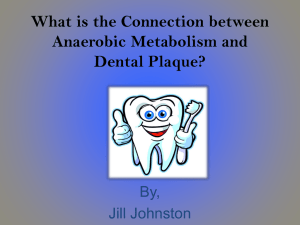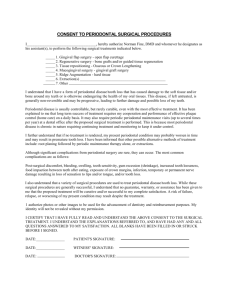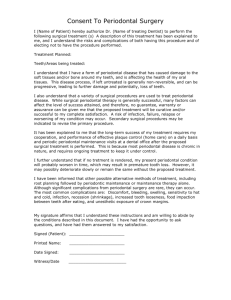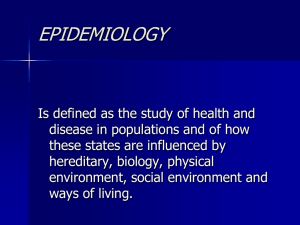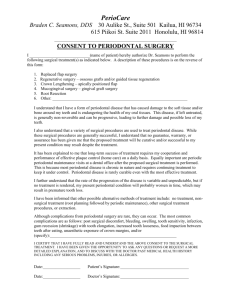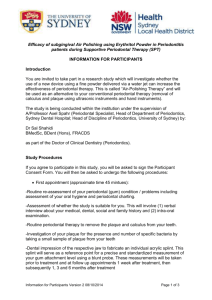Periodontal disease: Prevalence, Diagnosis, and Treatment Strategies
advertisement
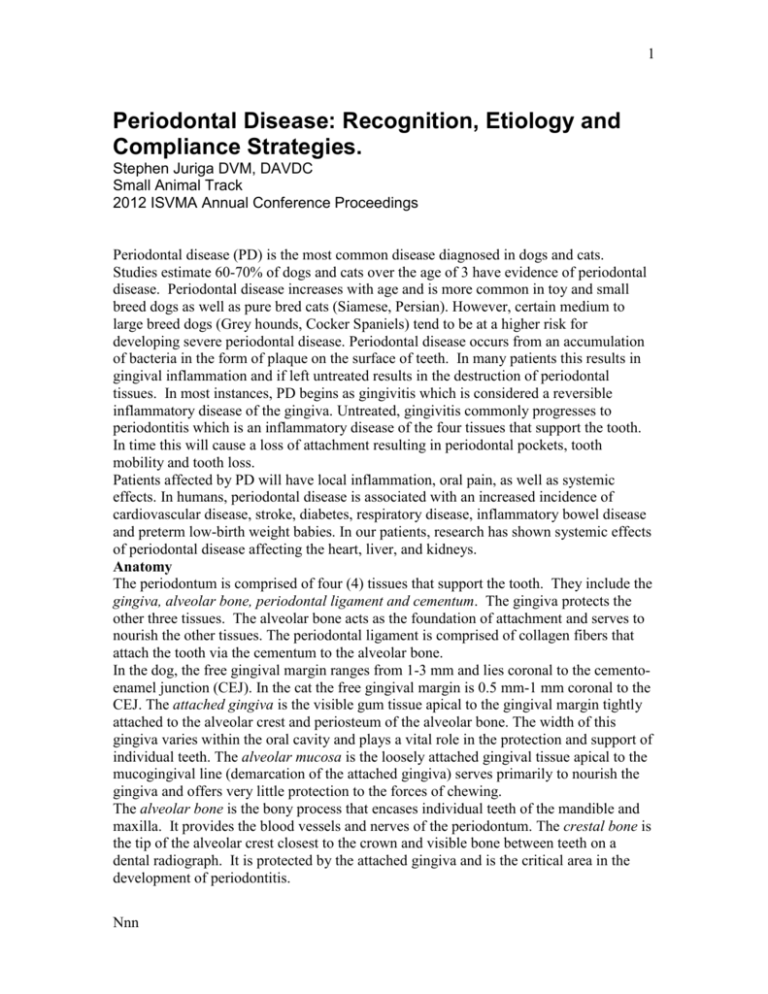
1 Periodontal Disease: Recognition, Etiology and Compliance Strategies. Stephen Juriga DVM, DAVDC Small Animal Track 2012 ISVMA Annual Conference Proceedings Periodontal disease (PD) is the most common disease diagnosed in dogs and cats. Studies estimate 60-70% of dogs and cats over the age of 3 have evidence of periodontal disease. Periodontal disease increases with age and is more common in toy and small breed dogs as well as pure bred cats (Siamese, Persian). However, certain medium to large breed dogs (Grey hounds, Cocker Spaniels) tend to be at a higher risk for developing severe periodontal disease. Periodontal disease occurs from an accumulation of bacteria in the form of plaque on the surface of teeth. In many patients this results in gingival inflammation and if left untreated results in the destruction of periodontal tissues. In most instances, PD begins as gingivitis which is considered a reversible inflammatory disease of the gingiva. Untreated, gingivitis commonly progresses to periodontitis which is an inflammatory disease of the four tissues that support the tooth. In time this will cause a loss of attachment resulting in periodontal pockets, tooth mobility and tooth loss. Patients affected by PD will have local inflammation, oral pain, as well as systemic effects. In humans, periodontal disease is associated with an increased incidence of cardiovascular disease, stroke, diabetes, respiratory disease, inflammatory bowel disease and preterm low-birth weight babies. In our patients, research has shown systemic effects of periodontal disease affecting the heart, liver, and kidneys. Anatomy The periodontum is comprised of four (4) tissues that support the tooth. They include the gingiva, alveolar bone, periodontal ligament and cementum. The gingiva protects the other three tissues. The alveolar bone acts as the foundation of attachment and serves to nourish the other tissues. The periodontal ligament is comprised of collagen fibers that attach the tooth via the cementum to the alveolar bone. In the dog, the free gingival margin ranges from 1-3 mm and lies coronal to the cementoenamel junction (CEJ). In the cat the free gingival margin is 0.5 mm-1 mm coronal to the CEJ. The attached gingiva is the visible gum tissue apical to the gingival margin tightly attached to the alveolar crest and periosteum of the alveolar bone. The width of this gingiva varies within the oral cavity and plays a vital role in the protection and support of individual teeth. The alveolar mucosa is the loosely attached gingival tissue apical to the mucogingival line (demarcation of the attached gingiva) serves primarily to nourish the gingiva and offers very little protection to the forces of chewing. The alveolar bone is the bony process that encases individual teeth of the mandible and maxilla. It provides the blood vessels and nerves of the periodontum. The crestal bone is the tip of the alveolar crest closest to the crown and visible bone between teeth on a dental radiograph. It is protected by the attached gingiva and is the critical area in the development of periodontitis. Nnn 2 The periodontal ligament is comprised of collagen fibers in a specific orientation that attach the tooth to the alveolar bone. The PDL fibers suspend the tooth within the alveolus and provides a “shock absorber” effect to prevent fracture of teeth during forceful occlusal action. The cementum is an acellular substance that covers the root of a tooth. It serves as the tissue of attachment for the PDL and seals the dentin of the root. Etiology The inflammation and destruction associated with PD is caused by accumulation of bacterial plaque on the tooth surface combined with the host immune response. Within minutes after a professional tooth cleaning a glycoprotein layer (acquired pellicle) covers the tooth. Bacteria readily colonize this glycoprotein layer to become biofilm or attached plaque. This plaque undergoes a maturation process in which aggregates of bacteria, bacterial by products, salivary components, oral debris and inflammatory cells develop into a complex micro-colony on the tooth surface. Over 2-3 days the soft plaque becomes mineralized to form dental calculus. This calculus plays a minor role in the progression of periodontal disease rather it primarily serves as a plaque retentative surface. Plaque associated with clinically healthy gingiva is comprised primarily of aerobic gram positive bacteria. While the subgingival flora associated with plaque/biofilm is comprised of mostly anaerobic gram negative bacteria: Porphyromonas, Prevotella, Fusobacterium and Spirochetes. As gingivitis develops the plaque extends subgingivally. This sibgingival environment is more suitable for growth of anaerobic species. In fact, hundreds of bacterial species inhabit the oral cavity and in most instances periodontal disease is an opportunistic infection secondary to gingivitis. The gram negative anaerobic bacteria stimulate a host immune response that is responsible for much of the tissue damage in periodontal disease rather than the virulence of the bacteria. Metabolic products and bacterial endotoxins stimulate the migration of neutrophils to the site of inflammation. These neutrophils engulf and digest bacteria which in turn “burst” releasing bacterial toxins and destructive enzymes that cause a breakdown of periodontal tissues. As this destructive cycle continues in the deeper tissues it results in a loss of alveolar bone to produce periodontitis. Oral malodor is a common finding as gram negative anaerobes are responsible for the sulfides and mercaptans that result in a pets halitosis. Recognition of Periodontal Disease Gingivitis is the inflammation of the gingiva. It is reversible and when the plaque and calculus are removed it disappears. Periodontitis is the inflammation of the alveolar bone and PDL. In fact it may be described as an “alveolar bone osteomyelitis”. Periodontitis causes a loss of attachment and maybe recognized by: Gingival recession that exposes the root Increase in probing depth apical to the cementoenamel junction Radiographic loss of bone surrounding the root A periodontal probe is an essential tool in the diagnosis of periodontal disease. This instrument has calibrated markings that measure gingival sulcular depth. The probing depth is a measurement from the gingival margin to the apical extent of the pocket and should be evaluated at 4 sites around each tooth. Normal probing depths range from 1-3 mm in dogs and 0.5 mm-1 mm in cats. The proper use of a periodontal probe provides valuable information on the extent and type of alveolar bone loss. Nnn 3 Periodontitis is described in terms of attachment loss. Gingival recession can be misleading as it must be added to the probing depth to determine attachment loss. Gingival hyperplasia appears as a gingival overgrowths resulting in pseudopockets that may contribute to subgingival plaque and periodontitis. Furcational exposure is an exposure of the area where the roots of multi-rooted teeth join the crown. Disease of the furcational region is graded 1-3 based on the depth a blunt periodontal probe may be placed in the region. Tooth mobility is an estimate of attachment loss that needs further evaluation. Radiographic imaging supports probing findings and allows visualization of alveolar bone and PDL. Bone loss from periodontal disease may be horizontal or vertical. Horizontal bone loss is a loss of bone parallel to the CEJ and appears uniform reduction in crestal bone height across all or part of the arcade. Vertical bone loss appears as a loss of bone angular or parallel to the root axis. Remember intraoral radiography underestimates the extent of bone loss as it requires a 40% change in bone density to be visible on a radiograph. Moreover, bone loss buccal or lingual/palatal surface is commonly hidden by superimposition of bone and tooth. Stages of Periodontal Disease The diagnosis and staging PD can be only estimated in the awake patient. On oral examination patients will have a swollen gingival margin or generalized inflammation of the attached gingiva. Halitosis is a common finding. The ideal oral examination should be performed under anesthesia. This allows for periodontal probing post teeth cleaning along with radiographic evaluation. In stage 1 (gingivitis) periodontal disease. Gingival inflammation is present. Some patients have significant dental calculus with minimal gingivitis while others may have moderate (marginal) inflammation with minimal plaque and calculus. This stage of PD is associated with inflammation, plaque, calculus, and bleeding on probing. However, on probing there is no attachment loss. In stage 2 (early periodontitis) periodontal disease, attachment loss has occurred. Again, there is significant variability in dental calculus and inflammation. Periodontal probing and radiographic examination may indicate up to 25% attachment loss and pocket depths of 3-5mm (in dogs) is common. These patients may have swollen gingiva, early furcation exposure, or mild gingival recession. In stage 3 (moderate periodontitis) periodontal disease, probing and radiographic evaluation indicates an attachment loss between 25% and 50% with probing depths from 6-9mm. These patients will commonly have furcational exposure at the base of multi-rooted teeth and may present with gingival recession. In stage 4 (severe periodontitis) periodontal disease, attachment loss is greater than 50%. It is not uncommon to have probing depths of greater than 9mm in dogs and 3mm in cats. These patients have mobile teeth, abscess formation, deep pockets, and advanced gingival recession. It is not uncommon to find deep infrabony pockets: On the palatal aspect of the maxillary canine teeth. Lingual aspect of the mandibular canine teeth. Interproximal space between the maxillary PM4-M1 or mesial/distal root of the mandibular first molar. Profession Periodontal Therapy Nnn 4 In our practice we have grouped similar steps and provide a 6-step approach to periodontal therapy for every patient. Therefore each patient to receives a systematic approach to provide the maximum benefit available. In simple terms the dental team must develop a “Routine”. A routine makes you less likely to leave steps out, minimizes human error, and makes you much faster. Since all dental patients are under anesthesia throughout the procedure (including the time spent charting) speed and efficiency are of paramount importance. Below is the six steps1 needed to provide professional periodontal therapy no matter how nominal the dental disease may appear. 1. Oral examination and preliminary charting 2. Supragingival and subgingival scaling 3. Polishing and irrigation 4. Diagnostics: Oral exam, probing, charting, and dental radiographs 5. Therapy as needed 6. Education about home care Step 1: Oral Examination and Preliminary Charting This step is where the pet’s teeth as well as the entire oral cavity are evaluated. This is accomplished with visual as well as tactile clues. Initially the entire oral cavity is evaluated for degree of calculus, gingivitis, tooth fractures, gum recession, oral masses, swellings or fistulas tracts. The oropharynx, palate, tongue and regions under tongue are examined. Next the pet’s dentition is counted and recorded in the pet’s dental chart. It may be helpful to do this using a system like the Tridan numbering system. In this system the oral cavity is divided into four quadrants. Each quadrant is evaluated starting from the midline then moving caudally. Step 2: Supragingival and Subgingival cleaning: Prior to the initiation of the periodontal therapy, the mouth is rinsed with an antiseptic solution generally chlorhexidine fluconate or acetate. This will decrease the bacterial numbers in the mouth, which in turn decreases the amount aerosolized as well as the degree of bacteremia induced by the prophylaxis procedure. This is cleaning the plaque and calculus on the teeth above the gum line. If the calculus is particularly heavy, a useful first step is to gently crack off the calculus with a calculus forceps. The majority of the plaque and calculus is removed with a mechanical scaler (ultrasonic or sonic). These instruments use electricity or compressed air to develop a 1 General anesthesia, with intubation is necessary to perform a proper cleaning of the tooth structures. This will protect the lungs from the bacteria that are being removed from the teeth as well as the bacteria present in the waterline of mechanical scalers. Anesthetic protocols, regional nerve blocks, fluid therapy, thermal support and patient monitoring are needed to provide patient safety. Moreover, the specific anesthetic agents are selected not only for patient safety but also to allow a complete recovery prior to dismissal. Finally, each dental patient will have a current physical examination, conscious oral examination and pre-anesthetic blood profile. Nnn 5 vibration at the scaler tip to efficiently remove calculus. The most efficient area of the mechanical scaling instrument is the side of the instrument 1-2mm form the tip. The back and tip of the instrument should not be used, as these are not effective areas of cleaning. The scaling instrument is placed in contact with the tooth surface utilizing a feather touch. The tip is run across the tooth surface in sweeping overlapping strokes maintaining contact as much as possible. Remember, plaque is invisible and coats all teeth. Therefore, make sure to cover every square millimeter of each tooth surface. It is recommended, however, that of ultrasonic instruments be utilized with sufficient water coolant and not be in contact with the tooth for more than 5-10 seconds to avoid overheating the tooth. Subgingival cleaning (under the gum line) is one of the most important steps. The subgingival plaque and calculus is the cause of gingivitis. If unchecked it will progress to periodontal disease. Periodontal disease is locally painful and predisposes a pet to systemic diseases (heart, liver and kidneys). Classically, subgingival cleaning is performed with hand instruments called curettes. These differ from scalers in that they have a blunted back and tip. Curettes are gently introduced under the gum line to the bottom of the gingival sulcus (or pocket), rotated slightly to engage the cutting aspect of the curette, and pulled upward to scrape/clean the root. This is repeated with numerous overlapping strokes until again, the root feels smooth. **Note** Recent developments in sonic and ultrasonic scalers have allowed for the utilization of these instruments under the gingival margin. There are several manufacturers that produce these instruments with subgingival tips. If you have any questions, however, make sure to ask your dealer which tip is safe for subgingival use. It should be noted again that ultrasonic scaler use alone might be insufficient for complete cleaning, especially when the subgingival tooth surface is diseased or irregular. After the teeth are completely clean, as evidenced by lack of plaque and calculus and the subgingival surface is smooth, the teeth re-examined. Residual plaque and calculus can be identified either with an explorer, a disclosing solution, or by drying the tooth with an air-water syringe. The later is especially useful for residual subgingival plaque by gently blowing the gingival sulcus open. Dried calculus will appear chalky white. Step 3: Polishing and Irrigation The mechanical removal of the plaque and calculus causes microscopic roughening of the tooth surface. This roughening increases the retentive ability of the tooth for plaque and calculus, which will buildup faster and increase the rapidity of periodontal disease progression. Polishing will smooth the surface and decrease the adhesive ability of plaque. This step is performed with a prophylaxis cup on a slow speed hand-piece at a rate of 13000 rpm and definitely not to exceed 5000 rpm. Prophy angles are 90 degree angled to allow easier access to the tooth surfaces. It is important to note that the prophy cup does not do the polishing, the polish does. Therefore, make sure you have plenty of polish on Nnn 6 the teeth and in the cup. The teeth are first coated with polish and then the prophy cup is filled as well. Disposable prophy angles/cups are recommended and are available in a twisting action to prevent hair entrapments. Again, every square mm of each tooth surface is polished. It is important to flare the edges of the prophy cup to polish the critical subgingival area. This flaring is accomplished by putting slight pressure downward on the tooth. Too much time or pressure will generate a great deal of heat. We recommend that you do not remain on one tooth more than 5 seconds when polishing. The scaling and polishing of the teeth will cause a lot of debris (plaque calculus, and prophy paste) to become trapped under the gingival margin. This may result in local inflammation, as well as increase the chance of forming a periodontal abscess. For this reason it is recommended to gently flush the gingival margin and tooth surfaces with the air-water syringe. Step 4: Diagnostics: Probing, Charting and Radiographs: This step of the procedure requires systematic approach, time, and dental knowledge. All time teeth are examined with a periodontal probe. The probe is inserted gently into the gingival sulcus and moved around the tooth measuring pocket depth. In addition to pocket depth, the astute dental practitioner will also note the degree of gingivitis, tooth mobility, sulcal bleeding, and furcation exposure on multirooted teeth. This information will direct X-rays and treatment strategies. It is important to check at least 4 spots on each tooth no matter how healthy the gingival appears. Normal sulcal depth is 1-3mm in dogs and 0.5-1.0mm in cats. All of the pertinent oral findings, the treatment(s) rendered, and planned therapy are placed on a dental chart in the patient’s permanent medical record. This will allow the veterinarian to follow the patient’s progress (or regression) though the years. Each dental chart will have a key or list of abbreviations that will allow recording of information easier. The chart becomes part of a pet’s medical record and may be sent with the petowner or reference to dismiss the pet. Dental radiographs are taken to determine the extent of the disease process present and to serve as a reference of the pathology present that prompted therapy. It is common for feline patients to receive full mouth radiographs at each periodontal treatment or cleaning. This is due to the high frequency of tooth resorptive lesions (previously referred to as odontoclastic resorptive lesions or FORL’s). Treatment options for tooth resorptive lesions require radiographs to evaluate root and bone structures. In our canine patients we use probing and charting to identify abnormalities. It is common for our canine patients to have 2-6 radiographs taken during a procedure. Common conditions that benefit from radiographs are fractured or discolored teeth, worn teeth, missing teeth, facial swelling, gum recession and periodontal pockets. **Note** Full mouth radiographs have been suggested for all feline and canine patients based on a published report in which, intraoral radiographs revealed clinically Nnn 7 important pathology in 27.8 % of canine patients and 41.7% of feline patients when no abnormal findings were noted on the initial examination. Step 5. Therapy as needed. After steps 1-4 are completed and the oral cavity evaluated, a plan is developed (with the pet-owners consent) to reestablish the patient’s oral health. Therapy may include: Subgingival Guided tissue Restorative therapy curettage regeneration Root canal therapy Root planning Extraction therapy Orthodontic therapy Bone countouring Gingivectomy Crown therapy Doxyrobe implant Oral surgery Bone grafting Biopsy Nnn 8 If this 6-step systematic approach is used and followed consistently, the patient will leave the practice with a clean mouth in which all pathology has been recognized and treated. If necessary the patient should be referred to a veterinary dentist (www.avdc.org) for advanced dental procedures just like most veterinary practices refer spinal and thoracic surgery. Remember, the plaque and associated disease will recur rapidly without follow-up home care. For this reason it is important to stress the final step (Home Care) to the owner and take time to coach them how to be successful. Step 6. Commitment to Home Care What would happen if we stopped brushing our own teeth? Even if we only ate hard food as some dogs and cats do, there still would be problems. Ideally, a pet’s teeth must be brushed regularly to offer the best prevention of future tooth and gum disease. As a second option, clients may select a prescription diet to reduce plaque. Tooth brushing is the single most effective means of removing plaque from the visible surface of the tooth. Brushing removes the daily accumulation of plaque from the teeth when it is still soft. Undisturbed plaque will mineralize and result in calculus, which is a hard substance that appears yellow or brown on the tooth surface. If untreated this will lead to gingivitis, pain, infection, and loss of teeth. Frequency of brushing is a well-debated topic among veterinarians. Once a day would be ideal, as this frequency is required to stay ahead of plaque formation, but for most owners this is unrealistic. One accepted protocol is to ask the clients to try for two or three days a week if the patient’s has good oral health. If the patient has established periodontal disease, however, daily brushing is usually necessary. Dietary texture also serves to reduce plaque quite well. Only the oversized, and highly abrasive kibble of Hills T/D diet will reduce the accumulation of plaque and calculus. Although not as effective as brushing, T/D does offer those unwilling patients the excellent option of prevention. Also, Eukanuba’s Veterinary Diets contain a dental defense system. A calculus inhibiting chemical, hexametaphosphate, has been added to the food and offers some prevention C.E.T Hextra, Veggiedent, or Oral hygiene chews for offer some abrasive cleansing action and antiseptic action as well. These items massage the gum tissue and should be used only as a supplement to tooth brushing or T/D diet. Cow hooves, bones, and hard plastic toys should be avoided. Chemical plaque inhibition: Chlorhexidine products (rinses or water additives) have been shown to reduce plaque formation. A gel called Maxiguad has also been shown to reduce gingivitis, anaerobic periodontal pathogens and plaque accumulation in cats. Xylitol-based drinking water additives may also reduce plaque and calculus scores by up to 53% in cats. It is important to use these products as adjuncts to mechanical tooth cleansing not as sole agents. 8


